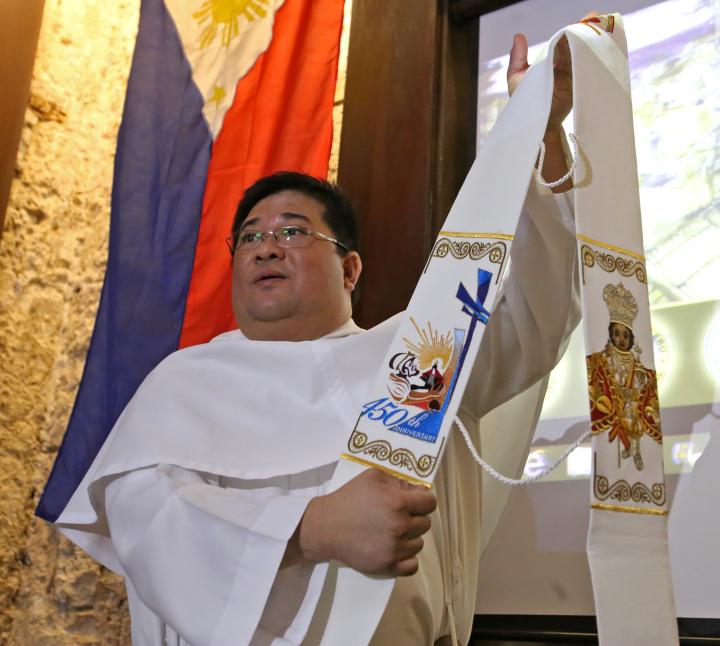Kaplag reenactment to be ‘dramatic theater’

Fr. Harold Rentosa, Kaplag executive director, shows the new stoles which priests will wear over their robes. Worn over the shoulders, the scarf-like garment will have the logo of the 450th Kaplag and image of the Sto. Nino. (CDN PHOTO/ JUNJIE MENDOZA)
A cast of 300 will reenact the ”Kaplag” or historic recovery of the Sto. Niño in the ruins of a pre-Hispanic village in a production covering three locations in Cebu City on Monday.
“We made it a point to make this year’s grand reenactment historically correct,” said award-winning stage and television director Floy Quintos in a press briefing yesterday.
“One should treat the reenactment as a theatrical performance.”
Ongoing rehearsals are being being coordinated with the Manila-based director and Cebuano choreographer Val Sandiego.
Part one will show the arrival of the 1521 arrival of Ferdinand Magellan and the Spanish soldiers either in Malacañang sa Sugbo or Fort San Pedro.
“One of these places will be transformed into a pre-hispanic village,” Quintos said.
Part 2 will show the planting of the Magellan’s Cross in its present kiosk in front of Cebu City Hall. The first Catholic baptism will be reenacted outside as the “palace” of Rajah Humabon.
The final venue is the Pilgrim center of the Basilica del Sto. Niño for the actual finding of the image of the Child Jesus.
The day will end with a 6:30 p.m. Mass presided by Manila Archbishop Luis Antonio Cardinal Tagle and about a hundred priests.
The choir will have 450 singers organized by the rector Fr. Jonas Mejares, OSA.
Months of research were spent looking into accounts of chroniclers like Henry Bayer, Miguel Lopez de Legaspi, Fray Andres de Urdaneta, and Antonio Pigafetta.
“We are very careful in interpreting everything, including the costume details and the characters,” Sandiego said.
The reenactment is being mounted by the Augustinian community with the National Commission for Culture and the Arts (NCCA).
April 28, 2015 marks the 450th anniversary of the discovery of the image of the Sto. Niño—the oldest religious icon and the symbol of Catholicism in the country.
The celebration also coincides with the 450th anniversary of the Augustinian’s presence in the country, and the 50th anniversary of the church’s title as a minor basilica.
When the group of Legazpi arrived in Cebu City from Spain in 1565, one of the soldiers, Juan Camus, found the image of the Sto. Niño inside a box amid a burnt settlement.
The image was originally given as baptismal gift by Magellan to Queen Juana of Cebu in 1521.
The finding of the Sto. Niño was interpreted as a sign of divine favor. Legazpi built a chapel on the very spot where the image was found. Presently, this place has been known as the Basilica Minore del Sto. Niño.
Disclaimer: The comments uploaded on this site do not necessarily represent or reflect the views of management and owner of Cebudailynews. We reserve the right to exclude comments that we deem to be inconsistent with our editorial standards.
